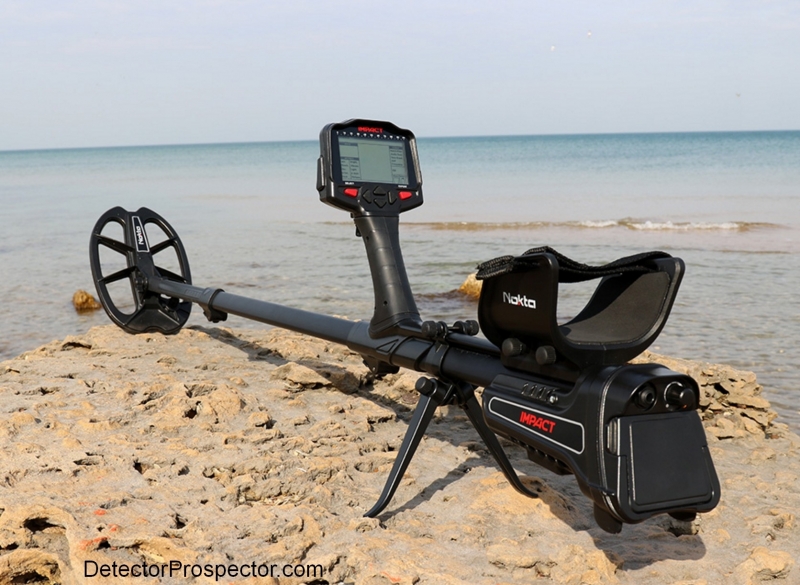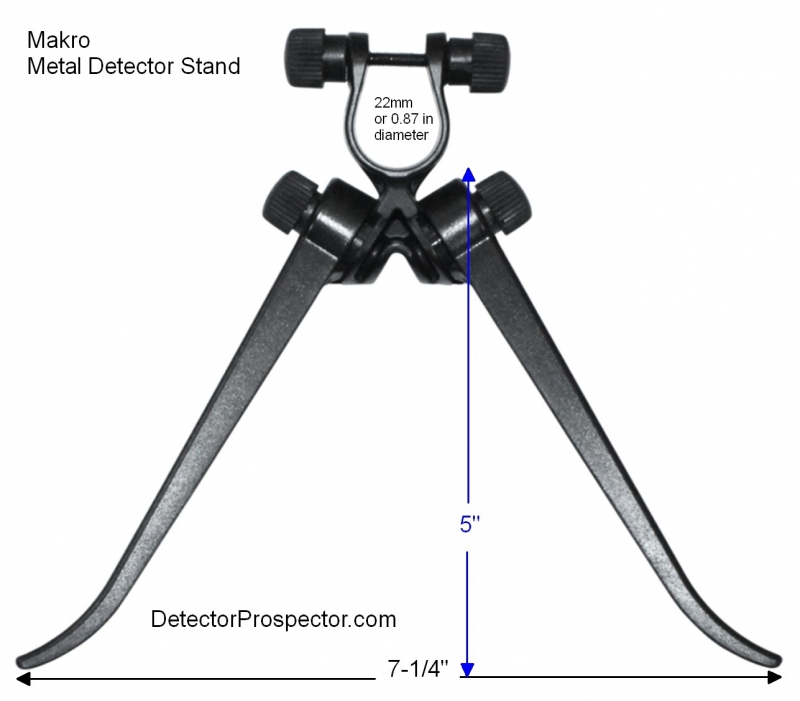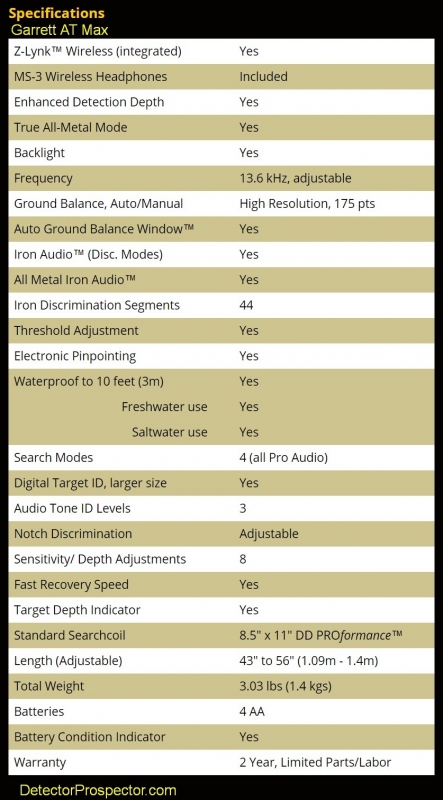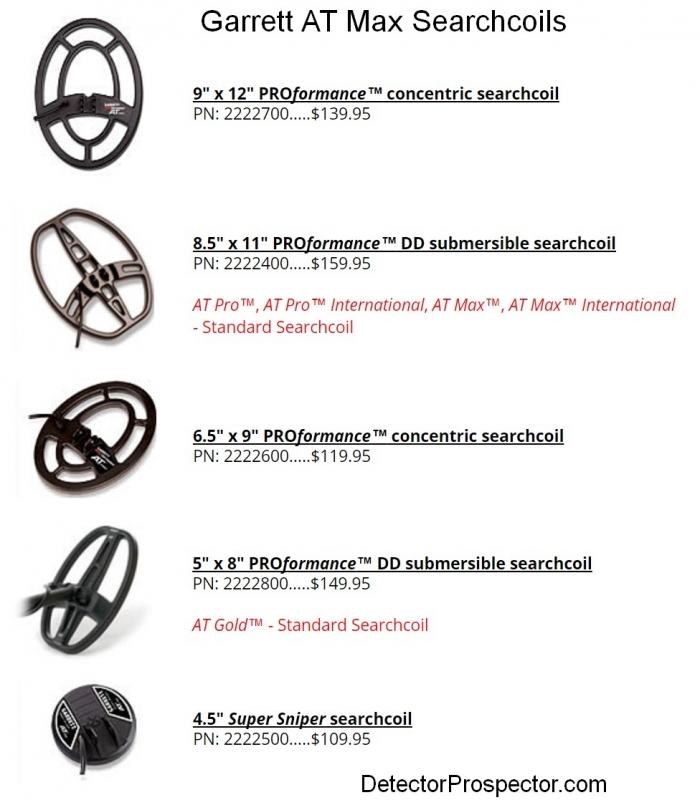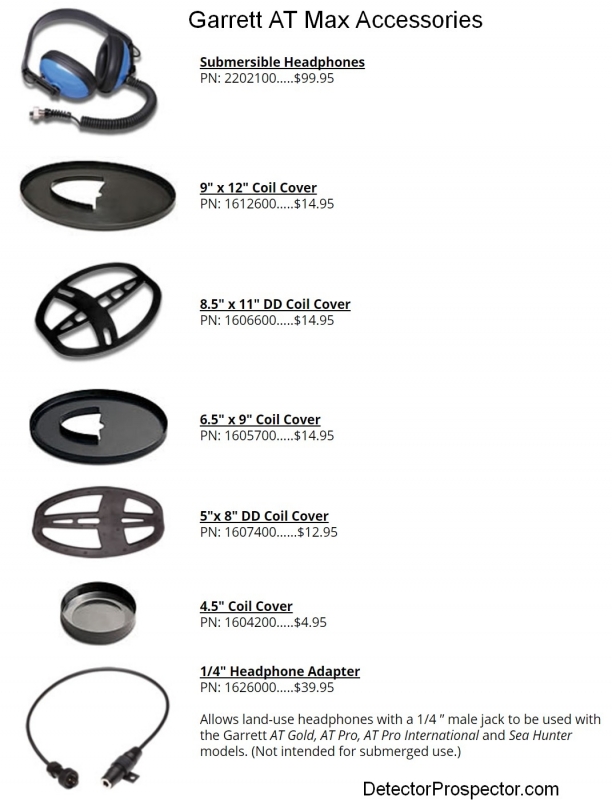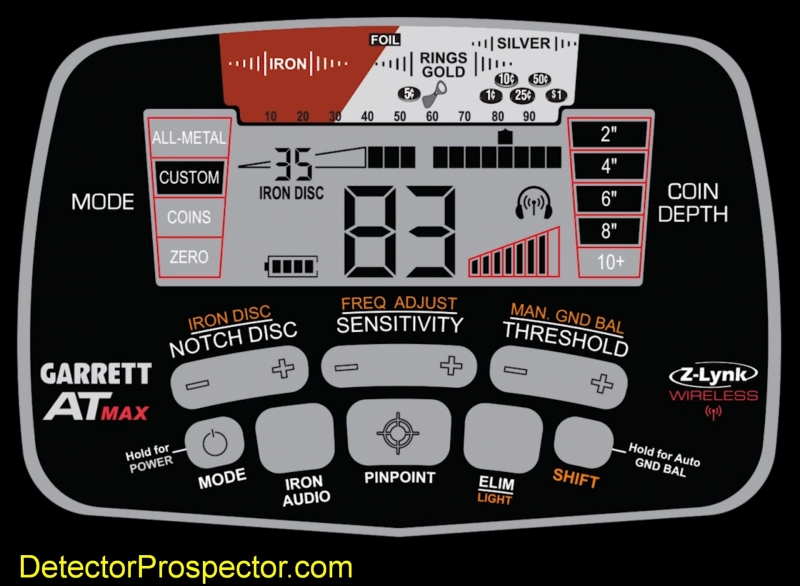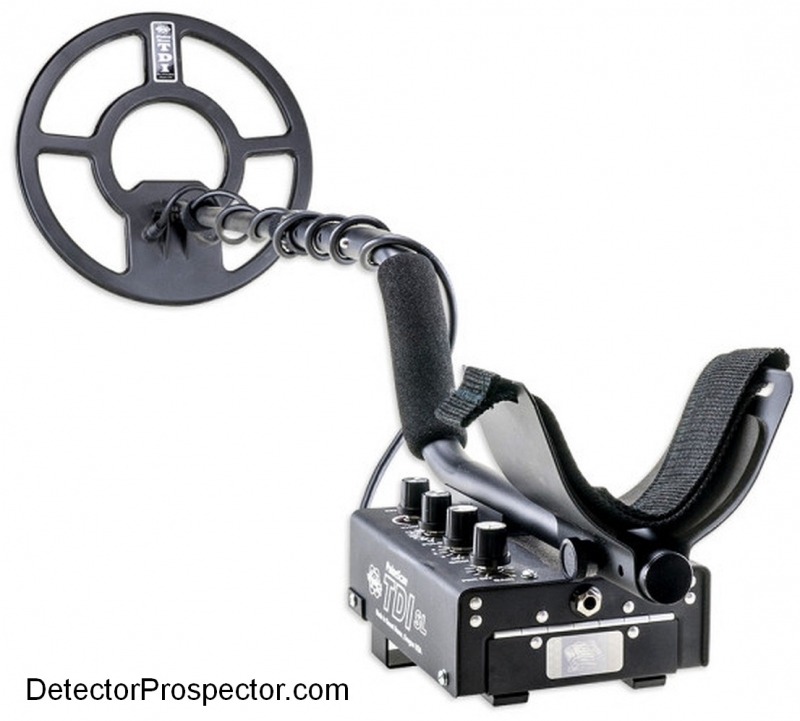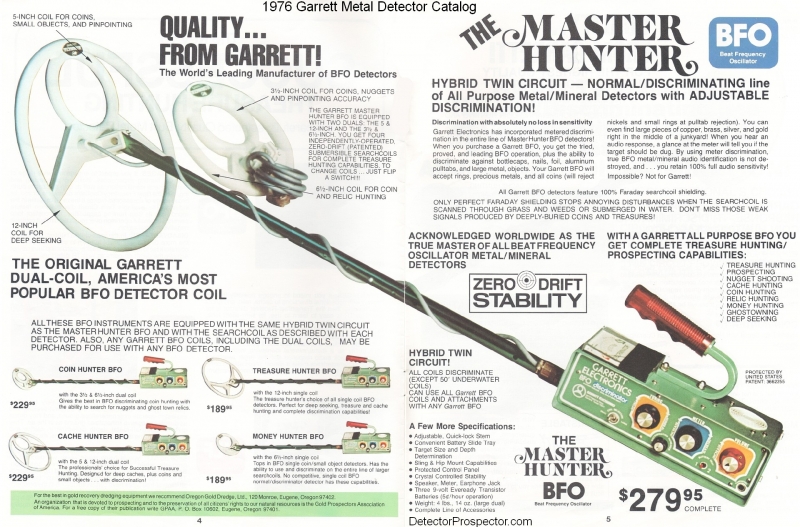-
Posts
19,756 -
Joined
Content Type
Forums
Detector Prospector Home
Detector Database
Downloads
Everything posted by Steve Herschbach
-
More grist for the rumor mill... http://www.dankowskidetectors.com/discussions/read.php?2,126142,126218#msg-126218
-
For those not aware, this is the same stand that was developed for the Nokta Impact, except that the Impact stand is designed to go around a triangular shaft. This new stand fits 22mm (0.87 inch) round shafts. The stands operate like a kickstand, with each side having the ability to flip back and out of the way when not in use. It is 7-1/4" wide at the bottom and holds the detector 5" off the ground.
-

Garrett AT Max Searchcoils & Accessories
Steve Herschbach replied to Steve Herschbach's topic in Garrett Metal Detectors
Obviously as shown above all Garrett AT Pro/AT Gold coils are also being sold as compatible with the AT Max. Now John at Findmall is confirming that the new Z-Lynk MS-3 wireless headphones will work just fine with existing Z-Lynk transmitter boxes. This in turn implies that the Z-Lynk receiver box will work with the AT Max, allowing people to wirelessly use whatever headphones they please. Good job Garrett! -

Audio Or Visual Target ID
Steve Herschbach replied to tboykin's topic in Metal Detector Advice & Comparisons
The one that is always flashing white, indicating the coil is charged up. It is weird, always flashing, even when the detector is sitting in a closet for six months. The ability to activate it to be a colored disc LED as you have described would certainly be more useful. From XP website "The LED on the coil gives 20 long, successive flashes to indicate that it is waking up and recalibrating. Once recalibration is complete, the coil becomes operational and its LED flashes every second. When the coil is on standby, its LED flashes every 4 seconds, whereas when it is on it flashes every second." -

Audio Or Visual Target ID
Steve Herschbach replied to tboykin's topic in Metal Detector Advice & Comparisons
Hmmm... if my Deus has a red/green LED someplace I am not seeing it. -

Audio Or Visual Target ID
Steve Herschbach replied to tboykin's topic in Metal Detector Advice & Comparisons
Nice, now I have not heard that idea before, and a good one! Since Deus is wireless, they could do a little stick on wireless module with your LED you could put anyplace. -

Minelab And Customer Communications
Steve Herschbach replied to Steve Herschbach's topic in Minelab Metal Detectors
It really is a cliche. There are plenty of outgoing personable engineers out there. I think it is more an introvert/nerd thing, and engineering just happens to be heavy on introvert/nerds. There is an overemphasis on taking things literally. Classic engineer communication issue: A wife asks her husband, a software engineer... "Could you please go shopping for me and buy one carton of milk, and if they have eggs, get six!" A short time later the husband comes back with six cartons of milk. The wife asks him, "Why the hell did you buy six cartons of milk?" He replied, "They had eggs." If you instantly understand that joke you lean to the engineer way of thinking. If you have to think much about it, then you are probably on the other side of the fence. I suffer from these issues myself, another hallmark being a certain blindness and insensitivity when it comes to others feelings. I have worked hard at being better over the years but foot in mouth just seems to go with the territory sometimes. My starting this thread may be a sign of such things once again at work! -

Audio Or Visual Target ID
Steve Herschbach replied to tboykin's topic in Metal Detector Advice & Comparisons
I did use to have a deaf customer back in the day and worked with him on detectors with meters. I am sure he would have loved the vibrate option. -

Audio Or Visual Target ID
Steve Herschbach replied to tboykin's topic in Metal Detector Advice & Comparisons
Well, with a good visual, say SpectraGraph, you hunt until you get a sound, then examine the screen. If deaf, with vibrate you hunt until you get tactile feedback (which is nuanced) but then also go to screen for the visual. In either case, you are being alerted as to when you need to look at the screen so you can detect without having to stare at the screen all the time. I see commentary from people saying they do not like screens because they do not like staring at the screen all the time, and I always wonder "why are you staring at the screen all the time?" You can look at is as much or as little as you please. Unless you are deaf and do not have the vibrate function. Being focused purely on the screen is actually dangerous to the safety of the operator. -
The Garrett AT Max page is now live on the Garrett website. Pdf Color Flyer here Coil and accessory options listed below. Click on images for larger versions.
-

Minelab And Customer Communications
Steve Herschbach replied to Steve Herschbach's topic in Minelab Metal Detectors
The post is not meant to be mean spirited. More tongue in cheek than anything... that is why it ends with a cartoon. It certainly is not a blame game on my part. It revolves more around the idea that companies have personalities as a whole rather than being about individuals or departments. Trust me, as a nerd/introvert my sympathies are with the engineers! -

Audio Or Visual Target ID
Steve Herschbach replied to tboykin's topic in Metal Detector Advice & Comparisons
My hearing sucks so I sympathize with hearing challenged and deaf individuals. It is on my to-do list to go detecting with the Nokta Impact using nothing but the vibrate function and screen. I will post the report when I get around to it. If forced to rely on visuals I much prefer the White's SignaGraph/SpectrGraph and Minelab CTX style systems for the extra info they offer over just straight up target id numbers. My DFX "iron smear" and CTX 'target trace" are pretty amazing compared to just a VDI number. -

Minelab And Customer Communications
Steve Herschbach replied to Steve Herschbach's topic in Minelab Metal Detectors
Indeed, where is that elliptical coil? Sadly it seems like a waste of time even asking XP, may as well just wait it out. -
This is just me following a random coffee inspired thought. It sure seems to me there is a disconnect between what customers expect by way of communications from Minelab and what Minelab perhaps thinks they are delivering by way of customer communications. The current example of course being the Gold Monster 1000 and customer and even dealer questions about what's up with the where and when. Minelab overall probably thinks they do a pretty good job with communications. Lots of customers and dealers probably feel otherwise. Where is the disconnect? Having rubbed shoulders with some Minelab folks for awhile I can offer this. They are a very engineering driven company. Literally a whole bunch of engineers, all engineering away doing engineer things. And truthfully, just a generally nice bunch of people, fascinating to chat with. Most of you would really enjoy having the opportunity to meet and talk with them, and I am quite lucky in that regard. There is this however. How many of you know engineers? Have you spent a lot of time talking to engineers? They are not really famous for communication skills. They might think they are communicating, but they are speaking a different language. Their brains are often wired differently than "regular folks". Yeah, it is a cliche, but cliches are often based on a certain reality. Think of Minelab as a large box full of engineers. Maybe really nice engineers, but engineers nonetheless. Then you might understand the communication thing. It is not just Minelab either. Minelab comes off as Suzy Socialite compared to Tesoro for instance. The industry as a whole has been remarkably slow at embracing the internet for what are after all technology companies. Garrett probably has it figured out the most but even they have been weirdly silent on the AT Max since the initial intro blurb - no other sign of it on the website yet. If this all seems far fetched consider this. I just Googled engineer communication skills and got 42,900,000 results! I love this quote from this article "According to Weisman, engineers take a 67% risk of damaging important relationships with people every time they speak." There are some good tips in that article for the companies.
-

Audio Or Visual Target ID
Steve Herschbach replied to tboykin's topic in Metal Detector Advice & Comparisons
Given the option I will always choose a machine with both, but at the end of the day I hunt by ear. Audio rules, visuals just add more information. I can easily hunt with a detector that has no visuals. I can't imagine hunting with a machine that has no audio! -
Certainly part of the problem with the TDI SL is that is is regarded as a less powerful detector than the original TDI and TDI Pro. I think a lot of people, including myself, were hoping that the original TDI would progress more rapidly into something that competed more aggressively with the Minelab models. There was a sense of White's getting into the race late as the underdog, but hopes this well respected U.S. manufacturer would show up that upstart company from Australia. Anybody that ever followed my TDI posts from day one can sense that was where I was pushing. We had the TDI, then the TDI Pro, and when the TDI SL came out I think people were hoping for an improved TDI Pro in the smaller, lighter package. Instead, the TDI SL seemed a step down in horsepower, leaving many White's fans expressing disappointment when it was released. And certainly nobody thought that was it, game over. A waterproof model was literally begged for by the fan base, to no avail. Now that the other TDI models have been dropped, the TDI SL is all that remains. I envision people out there with a popular VLF prospecting machine like the Gold Bug Pro, GMT, AT Gold, etc. These machines all sell for around $700 and weigh 2.5 - 3.9 lbs. They would like to add a ground balancing PI (GBPI) to what they have. I think that for "normal people" with normal budgets a machine under $2K and under four pounds just makes sense. It would be more than twice what they spent for their VLF, and in this day and age there is no reason why a decent PI should weigh over 4 lbs. Personally, I think the White's TDI SL is a very sweet machine ergonomically. About 3.5 well balanced pounds, built in speaker, drop in battery pack. The price brand new with two year warranty right now is fantastic - I am seeing them advertised at $1089.00 now, down from $1189.00. Ergonomically and pricewise only the TDI SL currently hits my desired under 4 lb under $2K category. The ATX at $2120 is nearly twice the price and at 6.9 lbs nearly twice the weight!! Kind of ridiculous and a source of never ending frustration for me. Why? Let's use what I call the Minelab rating scale. Details here. 1. Minelab SD 2000 - crude first version, very poor on small gold, excellent on large deep gold 2. Minelab SD 2100 - vastly refined version of SD 2000 3. Minelab SD 2200 (all versions) - adds crude iron disc, ground tracking 4. Minelab GP Extreme - adds greatly improved sensitivity to small gold, overall performance boost. 5. Minelab GP 3000 - Refined GP Extreme 6. Minelab GP 3500 - Greatly refined GP 3000, last and best of analog models 7. Minelab GPX 4000 - First digital interface, rock solid threshold 8. Minelab GPX 4500 - Refined GPX 4000, solid performer 9. Minelab GPX 4800 - Released at same time as GPX 5000 as watered down version 10. Minelab GPX 5000 - Culmination of the series, current pinnacle of GBPI prospecting machine technology. All Minelab models leverage an existing base of over 100 coil options from tiny to huge. I am a very practical person when it comes to prospecting. I know all the existing models and options by all brands very well, perhaps better than almost anyone. The way I look at it is this. If I personally were to plan to go to Australia for one month, and needed a GBPI detector, considering machines past and present, what would I take and in what order of choice? Put aside concerns of age, warranty, etc. just assume functioning detectors. Here is the issue in a nutshell. On the Minelab scale of one to ten as listed above, I would be generous in rating the TDI SL as a 2. Same with the Garrett Infinium. If I was going to spend a month of my time and a lot of money going on a prospecting trip to Australia, I would choose a TDI in any version over the SD 2000. I might go with a TDI Pro over a SD 2100 but I would have to think real hard about that, and push came to shove I would go SD 2100 were it not for the realities of age I said to ignore. A newer TDI Pro might be a better bet than a very old SD 2100 from a reliability standpoint, but again, this would be a tough choice. The TDI SL not really. I would be shooting myself in the foot to go on this hypothetical trip with a TDI SL instead of a SD 2100. You see the problem now? The Garrett ATX fares better. I would rate it a 3, roughly analogous to the SD 2200 variants. Still an agonizing choice really and the ATX being new versus SD 2200 being old might again be the tipping point, but from a pure prospecting options perspective the case can be made that the SD 2200 might be the better way to go. That's it folks. That is reality. The best of the best that the competition can offer can only go solidly up against models Minelab has not made in years. I am not saying that to be mean or as some kind of Minelab toadie, that is my pure unvarnished opinion as a guy who is pretty well versed on the subject. Let's bring it all home. This person with the $700 machine really, really wants that under 4 lb, under $2K GBPI machine, but if they do their homework they discover that truthfully, they would be better off shopping for a used Minelab than what the competition offers new. With the TDI SL rated as a 2 the ATX in a much lighter box at under $2K is a solid win as a 3. A well designed ATX with standard dry land coils would look very enticing as compared to the GP series Minelab's and with a stronger battery system might rate 4 to 6 on my comparative scale. But Garrett refuses to budge! White's can certainly do something, anything to improve the TDI SL. A battery that lasts all day would be a good start. In the end they are limited by the basic single channel design of the machine. The SD 2000 dual channel design was literally the answer to and the improvement on the single channel technology used in the TDI, the basics of which predate the SD 2000. Still, White's currently owns the under 4 lb under $2K GBPI category so they have the first out of the starting gate advantage. Anything they do would at the very least just show they have not given up. The Minelab MPS patent that formed the basis of the SD series has expired. Not sure about DVT, which formed the basis of the GP series. Where is the competition? What the heck is going on here? Much gnashing of teeth and pulling of hair is going on here, that's what!!! That is my challenge to the manufacturers. Under 4 lbs, under $2K, on the 1-10 scale I am offering, what is the best you can do? The TDI SL as a 2? Really? Yes, really, that is currently the best of the best in the brand new ground balancing PI, full warranty, under 4 lb, under $2k category. The White's TDI SL takes the crown; the rest of you should be hanging your heads in shame.
-

Does Anyone Still Make BFO Detectors
Steve Herschbach replied to FeO2digger's topic in Metal Detector Advice & Comparisons
Build your own.... http://www.geotech1.com/cgi-bin/pages/common/index.pl?page=metdet&file=projects.dat More homemade BFO detectors -

Does Anyone Still Make BFO Detectors
Steve Herschbach replied to FeO2digger's topic in Metal Detector Advice & Comparisons
That is news to me - BFO was on the way out when I got my first detector in 1972 and I went with that new-fangled T/R tech instead. BFO units have no ground canceling capability and so depth is extremely limited by today's standards. I have not heard of any sold new in many years. Another article by Carl Moreland BFO Theory Garret was a major manufacturer of BFO units and most used ones seen for sale were made by them. Here is their generic operating instruction manual. 2009 thread about looking for BFO detectors -
After the Fisher CZX, my wish list includes a suped up White's TDI SL or a stripped down Garrett ATX (about gave up on that, made my own), or a Nokta PI. Whites has the ergonomics and price right with the TDI SL but it lacks punch. The ATX has the horsepower but poor ergonomics priced too high (we need under 4 lbs and under $2K). Nok/Mak has stated they are working on PI but that's all we know. I guess while I am wishing I may as well wish for a Minelab GPX 2000 (integrated battery, under 4 lbs, under $2K) or a SDC 1500 (same deal). Recalculating, recalculating, recalculating.........
-
There is a previous thread with a lot of speculation about just what is going on with a couple of the Nokta Impact all metal modes, the Gen(D) and Sta(D) modes. The thought was that they are mixed modes - in other words modes that are running both all metal and disc in parallel. The speculation garnered attention and we have now been provided this explanation directly from Nokta Software Team Leader Alper Tozan regarding these 2 modes: ''I read a lot of comments about Gen (D) and STA (D) modes in some forums and firstly, I want to thank you about all your positive thoughts. On the other hand, I want to clarify one thing. In some forum discussions, these modes are defined as ‘’mix modes’’. These modes are not mix modes as mix modes typically result from at least two different software algorithms or hardware circuits working at the same time for decision making to discriminate and detect metals. These mix modes also show characteristics of two or more different modes at the same time including handicaps of each signal processing. Gen (D) mode, on the other hand, is a true threshold based all metal mode with motion that can discriminate metal without needing any other hardware or higher order software process level. So it always behaves like a classical true threshold based all metal mode but with iron tone and tone break.'' Frankly, for me that raises almost as many questions as it answers. Is an all metal mode that discriminates an all metal mode? Is it not instead a different kind of ferrous/non-ferrous discrimination mode? Whatever it is, it is unique, and that's enough for me! So I will do what I normally do and ignore what is going on under the hood and pay attention to just what it is these modes actually achieve by way of useful results in the field. More on that at a later date. From Nokta Impact Owners Manual, pages 12-13: Static Mode (STA) This is a non-motion mode. In other words, the device will generate an audio response when you hold the coil stationary without swinging over the target. The audio response increases in volume as the coil approaches the target. This mode is recommended for larger and deeper metals. In the STA mode, the device will generate the same audio tone for all metals and it will display the target ID on screen. At the same time, the ID scale will fill up to the right in proportion to the signal strength. Target ID range is 00-99. 00-40 are ferrous and 41-99 are non-ferrous metals. You can discriminate out all IDs below a certain ID by using the Disc. setting and simply avoid these metals in the field. When the device detects a discriminated metal, it will not produce an audio response or an ID. However, the ID scale will fill up to the right in proportion to the signal strength. The threshold in this mode is internal and cannot be adjusted by the user. Changes in the ground and temperature may lead to drifts in the threshold. Threshold drifts will be reflected in the ID scale either in the positive way (right side) or the negative way (left side). The device may emit an audible response in the positive drifts but not in the negative ones. When the threshold drifts, pull the trigger once to retune the detector. Retuning periodically while searching in this mode is recommended. IMPORTANT! For a more stable operation, try keeping the coil consistently at the same height above the ground where you retuned the detector. IMPORTANT! If you retune the detector over a target, the threshold will drift to the negative side and the device will no longer detect the target until the detector is retuned. In addition, the depth of the detector will also decrease. If the drifts are substantial and retuning does not improve the situation, increase the iSAT setting in the Expert Settings to a level where the drifts are eliminated (for detailed information on iSAT please refer to page 24). As the iSAT is increased, the device may detect weaker signals but will not be able to detect the targets anymore if you hold the coil stationary or sweep back and forth over the target. If the drifts still continue frequently, drop the gain to 39, decrease the iSAT and re-ground balance. Static Delta Mode (STA (D)) In principle, it works the same as the static mode. The difference is that the static delta mode will generate the same tone for ferrous and non-ferrous targets at fringe depths but it will discriminate the shallow ferrous targets by emitting a low iron tone. Also, Disc. setting is not available in this mode. Please refer to Table 2 at the end of the manual for different settings used in STA and STA (D) modes. General Search (GEN) Different than the other modes, this mode features a threshold tone which is continuously heard in the background. General Search (GEN) mode is used in 2 different ways in the IMPACT: 1) with the Disc. setting disabled at 0 2) with Disc. enabled (non-zero). When the device is first turned on, Disc. setting will be off. When the Disc. is set at 0, the device does not discriminate targets and detects all targets (metals, mineralized rocks etc.). ID of the detected target is shown on the display (except for negative hot rocks) and the same audio tone is provided for all targets. The audio tone increases in pitch as the coil approaches the target. This is the typical All Metal mode found in most detectors. When using the Disc. Setting in this mode, the device will emit a low ferrous tone for all targets below the Disc. Setting, and a higher tone for all targets above the Disc. setting which changes in pitch as the coil approaches the target. Let's say you set the Disc. to 20. The device will generate a low iron tone for all metals with 0-20 ID and a higher tone for all targets with 21-99 ID. Upon target detection, the threshold will momentarily go silent and only the target audio response will be heard. The duration of the threshold's silence is directly related to the level of the iSAT. Gain, threshold and iSAT settings in this mode are optimized to provide the best performance on different terrains. You can modify these settings based on ground conditions. We recommend using the GEN mode when discrimination is not important and not using it in heavy trash areas or areas containing many hot rocks. Audio Boost in the General Search Mode This feature is not included in the settings on screen. Boosts the sound of weak signals received from small or deep targets making it easier for you to detect those uncertain targets. It is recommended that audio boost should be used on a temporary or as-needed basis because it will not only boost the target signal audio but it will also boost the volume of ground noise and false signals along with the threshold hum. Audio Boost consists of 5 levels (b1-b5). At start up, the Audio Boost level is set to low (b1). To increase the Audio Boost level, pull the trigger and press the minus (-) button simultaneously. Audio Boost will only work in the GEN mode. General Search Delta (GEN (D)) In principle, it works the same as GEN mode. The difference is that the Gen (D) mode will generate the same tone for ferrous and non-ferrous targets at fringe depths but it will discriminate the shallow ferrous targets by emitting a low iron tone.
-
Well I hope so on all the above Des. As soon as I got wind of the Z-Lynk system I sent an email to Garrett urging them to make sure that wireless built into a detector would work with the separate receiver module and regular headphones, for people like me that have headphone preferences. And conversely the Z-Lynk headphones should be made to work with people who have existing Z-Lynk systems. I have to admit I have found it annoying that Minelab has made every version of the WM system incompatible. Hopefully Garrett has avoided doing the same.
-
The people who know won't say, and all the rest of us can do is guess. I will say I don't know. At this point I won't even bother guessing. All the price cutting and lineup shuffling does seem like they are making room at the top end for something. But next few months, end of year, early next year - who knows? These days wise money bets on later rather than sooner with any of the manufacturer's. 2015 Fisher Rumors
-
Congratulations on the meteorites Keith! Probably the first, most, largest and maybe the only ever found so far world wide with the Gold Monster 1000. Enjoy your place in the Guinness Book of World Records while it lasts!

